

Practical Suggestions for Scaffolding in the Content Classroom. Free Teaching Resources - Graphic Organizers. Printable Graphic Organizers. STW Filing Cabinet Logged in members can use the Super Teacher Worksheets filing cabinet to save their favorite worksheets.
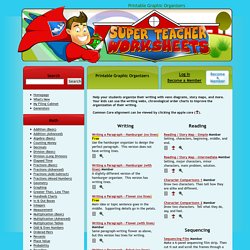
Quickly access your most commonly used files AND your custom generated worksheets! Please login to your account or become a member today to utilize this helpful new feature. :) [x] close This document has been saved in your Super Teacher Worksheets filing cabinet. Here you can quickly access all of your favorite worksheets and custom generated files in one place! Click on My Filing Cabinet in the menu at the upper left to access it anytime! Grade Level Estimation Title: Grade Level Estimation: 1st2nd3rd4th5th Grade level may vary depending on location and school curriculum. Common Core Standards Common core standards listing. All common core standards details. If you think there should be a change in the common core standards listed for this worksheet - please let us know. [x] close. Graphic Organizers Printables and Ideas - Print them - Venn Diagrams, Concept Maps, Writing, Character, Reading. Free Graphic Organizers.
Free Graphic Organizers for Teaching Writing. Introduction As you know, free graphic organizers are readily available on the Internet.
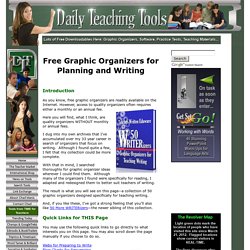
However, access to quality organizers often requires either a monthly or an annual fee. Here you will find, what I think, are quality organizers WITHOUT monthly or annual fees. I dug into my own archives that I've accumulated over my 33 year career in search of organizers that focus on writing. With that in mind, I searched thoroughly for graphic organizer ideas wherever I could find them.
The result is what you will see on this page--a collection of 50 graphic organizers designed specifically for teaching writing. And, if you like these, I’ve got a strong feeling that you’ll also like 50 More WRITERizers—the newer sibling of this collection. Quick Links for THIS Page You may use the following quick links to go directly to what interests you on this page. Graphic Organizers.
Features. A List of Free Graphic Organizers for Teachers and Students. Graphic organizers are visual representations of ideas and topics.

They are also called knowledge maps,story maps,concept maps,mind maps, cognitive organizers, advance organizers,or concept diagrams. Literature in the field of education strong supports the effective use of graphic organizers to enhance students learning and sharpen their critical thinking skills. Graphic Organizer Worksheets. Advertisement.

EnchantedLearning.com is a user-supported site. As a bonus, site members have access to a banner-ad-free version of the site, with print-friendly pages.Click here to learn more. (Already a member? Click here.) Effective Literacy Instruction Worksheets and Templates. Skip to content Worksheets & Templates We’re a bit obsessed about effective literacy instruction and that’s why we’re always building our library of literacy worksheets and templates.

Take a minute and review the list. You’ll likely find something that you can use to support your activities. Below are Keys to Literacy worksheets, templates, and other instructional material associated with our programs. From The Key Comprehension Routine From The Key Vocabulary Routine. Teacher Resources. Parks.sandi.net/pages/sitp/SITP PD/Academic Language Devel PP.pdf. Gonzagateach - Academic Language. 5 Key Strategies For ELL Instruction. English Language Learners (ELLs) face the double challenge of learning academic content as well as the language in which it is presented.
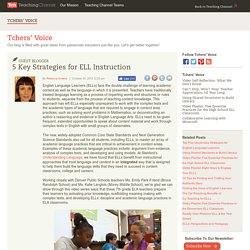
Teachers have traditionally treated language learning as a process of imparting words and structures or rules to students, separate from the process of teaching content knowledge. This approach has left ELLs especially unprepared to work with the complex texts and the academic types of language that are required to engage in content area practices, such as solving word problems in Mathematics, or deconstructing an author’s reasoning and evidence in English Language Arts.
ELLs need to be given frequent, extended opportunities to speak about content material and work through complex texts in English with small groups of classmates. Working closely with Denver Public Schools teachers Ms. Emily Park-Friend (Bruce Randolph School) and Ms. Scaffolding Understanding Purposeful Grouping Background Knowledge. ESL Teachers, Academic Language, and the Common-Core Standards - Learning the Language. Making the rigorous common-core standards in English/language arts and mathematics accessible to every type of learner is a huge undertaking for educators.
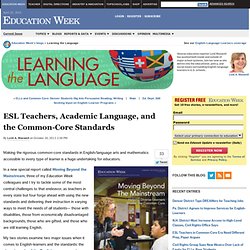
In a new special report called Moving Beyond the Mainstream, three of my Education Week colleagues and I try to tackle some of the most central challenges to that endeavor, as teachers in every state but four forge ahead with using the new standards and delivering their instruction in varying ways to meet the needs of all students— those with disabilities, those from economically disadvantaged backgrounds, those who are gifted, and those who are still learning English. Teaching Content and Academic Language Concurrently. Posted onFebruary 27, 2013byMaryEllen Vogt One reason that the SIOP Model has struck a nerve with so many educators, in addition to the proven academic gains for English learners, is that teachers see that we cannot wait until English learners are proficient in academic English before we teach them the grade-level content concepts they need to succeed.

Also, teachers have realized that just because students seem to speak English effortlessly when they’re on the playground or in the lunchroom, it doesn’t mean that they have mastered academic English, “the set of words, grammar, and organizational strategies used to describe complex ideas, higher-order thinking processes, and abstract concepts” (Zwiers, 2008, p. 20). Resources / Teaching Academic Language. What is Academic Language?
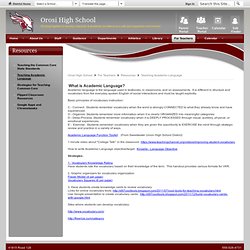
Academic language is the language used in textbooks, in classrooms, and on assessments. It is different in structure and vocabulary from the everyday spoken English of social interactions and must be taught explicitly. Basic principles of vocabulary instruction: C - Connect: Students remember vocabulary when the word is strongly CONNECTED to what they already know and have experienced. O - Organize: Students remember more information when it is clearly ORGANIZED into meaningful categories D - Deep-Process: Students remember vocabulary when it is DEEPLY PROCESSED through visual, auditory, physical, or emotional experiences. E - Exercise: Students remember vocabulary when they are given the opportunity to EXERCISE the mind through strategic review and practice in a variety of ways.